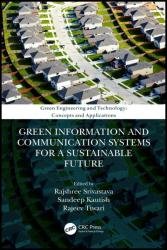 Название: Green Information and Communication Systems for a Sustainable Future
Название: Green Information and Communication Systems for a Sustainable FutureАвтор: Rajshree Srivastava, Sandeep Kautish, Rajeev Tiwari
Издательство: CRC Press
Год: 2021
Страниц: 272
Язык: английский
Формат: epub
Размер: 16.5 MB
Green Information and Communication Systems for a Sustainable Future covers the fundamental concepts, applications, algorithms, protocols, new trends, challenges, and research results in the area of Green Information and Communication Systems. This book provides the reader with up-to-date information on core and specialized issues, making it highly suitable for both the novice and the experienced researcher in the field.
The book covers theoretical and practical perspectives on network design. It includes how green ICT initiatives and applications can play a major role in reducing CO2 emissions, and focuses on industry and how it can promote awareness and implementation of Green ICT. The book discusses scholarship and research in green and sustainable IT for business and organizations and uses the power of IT to usher sustainability into other parts of an organization.
Nowadays, green computing is one of the major challenges for most IT organizations that involve medium- and large-scale distributed infrastructures like grids, clouds, and clusters. This book will focus on solutions for all aspects of green computing issues, such as energy efficiency, carbon footprint reduction, and temperature control management. The trade-offs between energy efficiency and performance have become key challenges that must be addressed in both distributed and traditional performance-oriented infrastructures. Particularly relevant is the so-called smart grid technology, seeking to optimize electricity distribution, especially electricity generated from renewable sources, and to promote the use of smart devices (including smart homes and autonomous cars), that require further research on distributed communications, energy storage, and the integration of various sources of energy.
Wireless Sensor Networks (WSNs) nowadays are treated as an emerging technology, used for various applications like investigation of natural resources, tracking of static or dynamic targets, and in areas which it is not easy to access. A WSN consists of different types of sensors, which may be homogenous or heterogeneous. The main challenges faced in WSNs, which degrade the performance, are computational, battery lifetime, security, and localization. The localization process is used in order to assign the coordinates to unknown target nodes deployed in the sensor field. Localization techniques can be used in WSNs for different applications, such as tracking of targets and location tracking of target nodes, etc. Many researchers have presented a variety of localization algorithms for improving important parameters, namely accuracy and efficiency. These techniques are mainly classified as either range-based or range-free localizations. Techniques, such as received signal strength indicator (RSSI), time of arrival (TOA), time difference of arrival (TDOA), angle of arrival (AOA), are classified as range-based techniques. The range-based localization techniques are used for calculating the position of the node with range information (based on angle or distance). A huge cost is involved in implementing range-based methods but these methods are more effective at localizing the node effectively and for guaranteeing accurate node localization, as compared with range-free techniques. Some range-free techniques are classified as Centroid Method, DV-Hop, approximate point in triangulation (APIT) and multidimensonal scaling (MDS). The benefit of using range-free methods is their ease of operation and low overheads.
Business and management educators, management researchers, doctoral scholars, university teaching personnel and policy makers as well as members of higher academic research organizations will all discover this book to be an indispensable guide to Green Information and Communication Systems. It will also serve as a key resource for Industrial and Management training organizations all over the world.
Contents:
Chapter 1 A Review on Localization in Wireless Sensor Networks for Static and Mobile Applications
Chapter 2 Literature Survey on Data Aggregation Techniques Using Mobile Agent and Trust-Aware in Wireless Sensor Network
Chapter 3 Intelligent Transport Systems and Traffic Management
Chapter 4 Data Mining and E-banking Security
Chapter 5 Renewable Energy Sources
Chapter 6 A Review of the Internet of Things (IoT): Design and Architectures
Chapter 7 Hybrid Energy Systems
Chapter 8 Power Quality Analysis of a Wind Energy Conversion System Using UPFC
Chapter 9 Electric Energy Systems
Chapter 10 Power Quality Analysis Using Various Computational Techniques for Induction Machines
Chapter 11 Smart Home (Domotics)
Chapter 12 Developing Ecosystem for Tracking Vehicles in Disaster Prone Areas
Chapter 13 Offline Payment System for Public Transport
Chapter 14 Microbial Fuel Cell: A Source of Bioelectricity Production
Index
Скачать Green Information and Communication Systems for a Sustainable Future